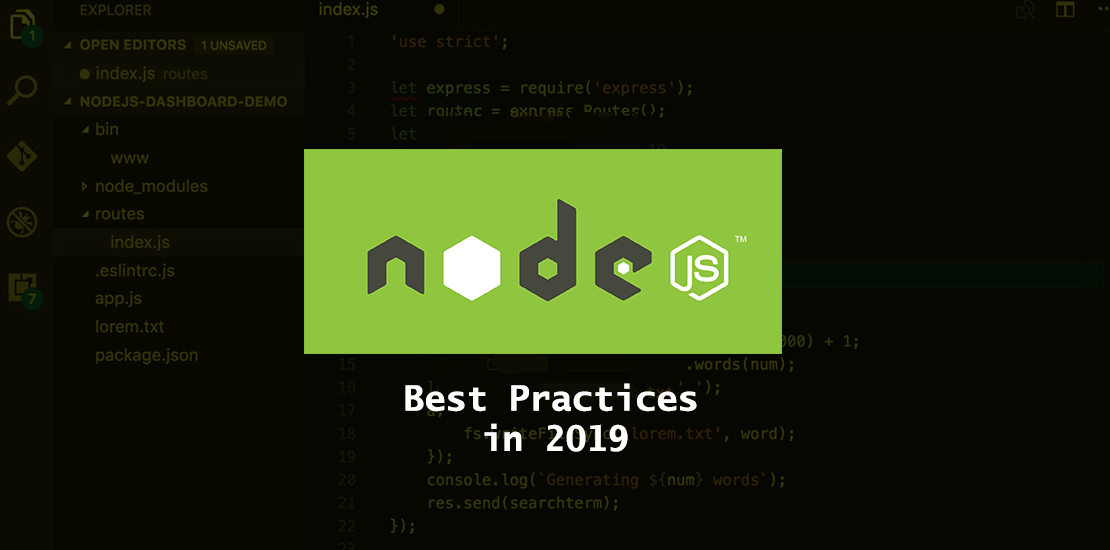Best Node.js Practices to Become a Kick-Ass Developer in 2019

If you ever thought that Node.js is only good as a side-kick, you badly need to go through your decision once again. Because a few years back that might have been true, however, now it’s the most used and hyped-up tool of JavaScript- which is the most commonly used language itself.
In case you’re still in dilemma; according to 2018 survey, 49.9% -which is the highest percentage compared to other tools and libraries- of professional developers prefer Node.js over Angular, React, Django, and the rest.
So, if your New Year resolution was to be a kick-ass developer, Node.js is a way to start. Though, keep in mind that Node.js is still a relatively new technology and is continuously getting revamped from time to time for an easier and more efficient programming.
Here in this article, we have shared some top class tips for 2019 that can help you build bombastic applications,
-
Security Breaches Can Screw You Over
Secure your Node.js application and make it your first priority. Security screws had been a sore topic last year, because of the many vulnerabilities and weak aspects found in the system. 
- With the help of authorization, you can deploy a rate limiter that can keep in check the access demands made on a time window.
- Cookies can be a cause security slips at times. A definitive scope and flags should be set in an accurate order, along with trailing the URL path from where they’re sent.
- To avoid any loopholes during transmission, sensitive data can be protected with HTTP and encryption methods like SSL and TLS. 256-bit encryption can also fend-off most of the attackers.
- Lastly, run your apps through Synk, Data Validation, Brute Force Protection, and Node Security Platform for any conniving vulnerabilities and vicious attacks.
-
Deploy Asynchronous Programming

To set your Node.js programming and developing environment, there are basically two ways,
- Synchronous: Each operation needs to be completed before the start of the next one.
- Asynchronous: Multiple tasks can be executed simultaneously because of available resources.
You can perfectly deduce which way is the best and that is asynchronous programming- Async-Await. With the release of Node.js8 Promise-based codes can be written through async functions. Moreover, callbacks can also be replaced by a synchronous-looking asynchronous code. This allows all the rip-roaring and confusing code bases to be handled simply and efficiently.
-
Use Micro-service Architecture And Use Containers

Micro-services are basically an approach to app development that acts as a single self-functional system to be developed and scaled separately from other parts of the system. For instance, if a micro-service fails, it can be removed independently without putting the whole app on the stake. As Node.js is based on micro-service architecture, containers can be used to make your app work-up slicker than ever. For this, you need to smooth your way to two techs this year,
- Docker: This software technology can generate containers that can help with not only security of your app, but also provide you with a complete file system that contains all the resources like code, system tools, libraries, and runtime.
- Kubernetes: It is an open source system that can automate containerized apps with deployment, scalability, and management.
-
Apply “Twelve-Factor App” Manifesto
With the use of Kubernetes and Docker, it’s all the more necessary to first enhance your existing code. And that can easily be done with the help of these 12 principles that state how the apps and code should be developed and written, respectively.
- One control tracked in revision controlled, many deploys
- Explicitly declare and isolate dependencies
- Store configuration in the environment
- Treat backing services as attached resources
- Strictly separate build and run stages
- Execute the apps as one or more stateless processes
- Export service via port binding
- Scale-out via the process model
- Maximize robustness with fast startup and graceful shutdown
- Keep development, staging, and production as similar as possible
- Treat logs as event streams
- Run admin/management tasks as one-off processes
-
Import and Import () Integration Should Be Started
Although there is still time for ES modules to become production ready in terms of stability and scalability, it is already all over the place on transpilers and certain libraries. Encapsulated in the experimental module flag, they’ve been supported since Node.8.5.
Therefore, it’s high time that you start learning the basics of import and import () and follow through all the improvisation and growth phases this year.
-
Monitor Your Application Performance

While dealing with a composite network of application with integrated micro-services. There are bound to be some errors in your service. These errors might appear minor at first and bring down your whole system when they get through with it. Howbeit, identifying and solving them in the beginning –before your users take notice or these errors start causing problems- is the most vital part. And this needs some eminent monitoring.
- There are APM (Application Performance Monitoring) tools that continuously keep in check metrics like database remission, memory usage, and others.
- Open or distributed tracing gives visibility and information about cross-process communication, by using two basic elements; Span and Trace.
Node.js is rapidly expanding its horizons, but as a developer, it’s you who can help in this progress. And how exactly you can help?
Simply, by contributing to the open-source projects!

